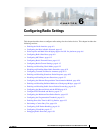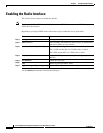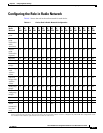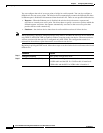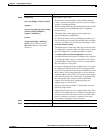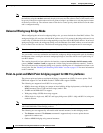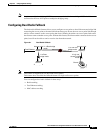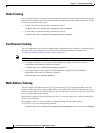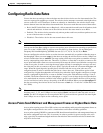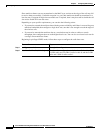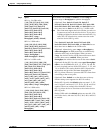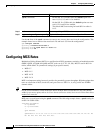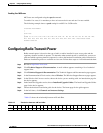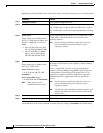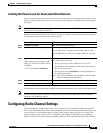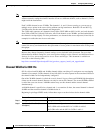
6-9
Cisco IOS Software Configuration Guide for Cisco Aironet Access Points
OL-30644-01
Chapter 6 Configuring Radio Settings
Configuring Radio Data Rates
Configuring Radio Data Rates
You use the data rate settings to choose the data rates the wireless device uses for data transmission. The
rates are expressed in megabits per second. The wireless device attempts to transmit at the highest data
rate set on the CLI or GUI interfaces. If there are obstacles or interference, the wireless device steps
down to the next lower rate that allows data transmission. You can set each data rate to one of three states:
• Basic (the GUI labels Basic rates as Required)—Allows transmission at this rate for all packets, both
unicast and multicast. At least one of the wireless device's data rates must be set to Basic.
• Enabled—The wireless device transmits only unicast packets at this rate; multicast packets are sent
at one of the data rates set to Basic.
• Disabled—The wireless device does not transmit data at this rate.
Note At least one data rate must be set to basic.
You can use the Data Rate settings to set an access point to serve client devices operating at specific data
rates. To set the 2.4-GHz, 802.11g radio to serve only 802.11g client devices, set any Orthogonal
Frequency Division Multiplexing (OFDM) data rate (6, 9, 12, 18, 24, 36, 48, 54) to Basic.
You can configure the wireless device to set the data rates automatically to optimize either the range or
the throughput. When you enter range for the data rate setting, the wireless device sets the 1 Mbps rate
to basic and the other rates to enabled. The range setting allows the access point to extend the coverage
area by compromising on the data rate. Therefore, if you have a client that is not able to connect to the
access point while other clients can, one reason may be because the client is not within the coverage area
of the access point. In such a case using the range option will help in extending the coverage area and
the client may be able to connect to the access point. Typically the trade-off is between throughput and
range. When the signal degrades (possibly due to distance from the access point,) the rates will
renegotiate down in order to maintain the link (but at a lower data rate). Contrast that against a link
configured for a higher throughput that will simply drop when the signal degrades enough to no longer
sustain a configured high data rate, or roam to another access point with sufficient coverage, if one is
available. The balance between the two (throughput vs. range) is one of those design decisions that has
to be made based on resources available to the wireless project, type of traffic the users will be passing,
service level desired, and as always, the quality of the RF environment.When you enter throughput for
the data rate setting, the wireless device sets all data rates to basic (i.e. 12 rates for 2.4 Ghz and 8 rates
for 5 GHz).
Note When a wireless network has a mixed environment of 802.11b clients and 802.11g clients, make sure
that data rates 1, 2, 5.5, and 11 Mbps are set to required (basic) and that all other data rates are set to
enable. The 802.11b adapters do not recognize the 802.11g rates and do not operate if data rates higher
than 11Mbps are set to require on the connecting access point.
Access Points Send Multicast and Management Frames at Highest Basic Rate
Access points running recent Cisco IOS versions are transmitting multicast and management frames at
the highest configured basic rate, and is a situation that could causes reliability problems.
Access points running LWAPP or autonomous IOS should transmit multicast and management frames at
the lowest configured basic rate. This is necessary in order to provide for good coverage at the cell's
edge, especially for unacknowledged multicast transmissions where multicast wireless transmissions
may fail to be received.



